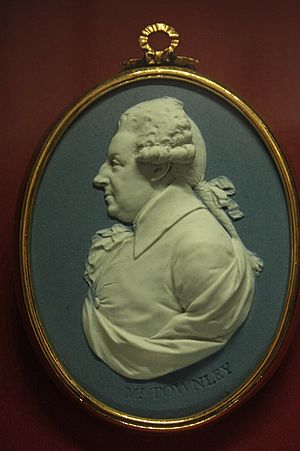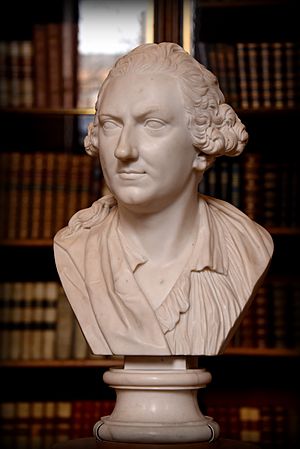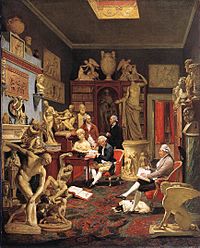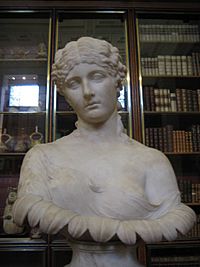Charles Townley facts for kids
Charles Townley (born October 1, 1737 – died January 3, 1805) was a rich English gentleman. He loved old things and collected many ancient artworks. He traveled to Italy three times, buying old sculptures, vases, coins, and drawings. Many of his most important pieces are now in the British Museum. These are known as the Townley Marbles.
About Charles Townley

Charles Townley was born at Towneley Hall in England on October 1, 1737. This was his family's home near Burnley. His family was Catholic, so he could not go to English universities. He also could not hold public office. He was educated at the English College, Douai, and later by a scientist and priest named John Turberville Needham.
In 1758, Charles Townley lived at Towneley Hall. He lived a normal country life until 1765. That year, he left England for a trip called the Grand Tour. This was a long trip through Europe, especially Italy. He visited Rome in 1765, 1772–1773, and 1777. He also explored Southern Italy and Sicily.

Townley worked with art dealers like Gavin Hamilton and Thomas Jenkins. They helped him build a wonderful collection of ancient items. His collection became famous for the "Towneley Marbles." In 1778, he moved his collection to a special house in London. He died there on January 8, 1805.
Charles Townley wrote only one published article. It was about the Ribchester Helmet. This was a Roman cavalry helmet found near Towneley Hall. It is now in the British Museum. In 1791, he became a Fellow of the Royal Society. This is a group for important scientists. He also became a trustee of the British Museum in 1791. This meant he helped manage the museum.
The British Museum bought many of Townley's old papers in 1992. These papers include his diaries, bills, letters, and lists of his collections.
In 1807, a sculptor named Joseph Nollekens made a bust of Townley. A bust is a sculpture of a person's head and shoulders. This bust shows Townley with messy hair and a thoughtful look. The bust was bought by the National Heritage Memorial Fund. They helped return it to Towneley Hall Museum. This museum is in his old family home.
The Townley Collection
The ancient items collected by Charles Townley are now called the Townley Collection. They are kept at the British Museum. There are about 300 items in total. This collection includes many important Greek and Roman sculptures and other artifacts.
Some famous pieces in the collection are:
- The Cannibal: A broken sculpture of two boys playing with knucklebones.
- Bust of Clytie: Townley thought this was a goddess coming out of a lotus flower.
- Townley Hadrian
- Townley Antinous
- Cista Mystica
- A relief (carved picture) of Pan with Jupiter and three nymphs.
- Two statues of Pan, made by Marcus Cossutius Cerdo.
- Tombstone of the shoemaker Xanthippos.
- Townley Caryatid
- Townley Discobolus: A famous statue of a discus thrower, from Hadrian's Villa.
- Townley Greyhounds
- Townley Sphinx
- Townley Vase: A large vase from a Roman villa.
- Townley Venus
When Townley died in 1805, his family sold his collection of marbles, large bronzes, and terracottas. The British Museum bought them for £20,000. This was probably much less than what Townley paid for them. The museum got special money from the government for this purchase. The smaller items, like coins and pottery, were bought in 1814.
Charles Townley had planned to leave his collection to the British Museum in his will. But just before he died, he changed his mind. He decided to leave it to his brother and uncle. He wanted them to display the sculptures in a special gallery. A gallery was built, but the British Museum's collection kept growing. The original museum building, called Montague House, became too small. So, the old building was taken down in 1823. It was replaced with the grand building we see today.
The Famous Painting by Johann Zoffany

Charles Townley became the most famous person in his family. One of the treasures at Towneley Hall today is a painting by Johan Zoffany. This painting shows Townley in his London home. He is surrounded by many of his most important sculptures. Over forty sculptures are shown in the painting.
In the painting, Townley is talking with three friends. They are Charles Astle, Charles Francis Greville, and Pierre-François Hugues d'Hancarville.
In the front of the painting, you can see Townley's Roman marble statue of the Discobolus. There is also a Nymph with a Shell and a Faun. The Boys Fighting sculpture is on a stand in front of the fireplace. This was Townley's first big purchase in 1768.
The Bust of Clytie is on a small writing table in the painting. This bust was copied many times in marble and other materials. The writer Goethe owned two copies of it. The Bust of Clytie was probably Townley's favorite sculpture. He even took it with him when he had to leave his home during the anti-Catholic Gordon Riots in 1780.
The Townley Venus statue is on a Roman well-head. This statue was found by Gavin Hamilton at Ostia Antica. He secretly shipped it out of Italy in two pieces. The marble Townley Vase is also in the painting, on a bookcase. It was also found by Gavin Hamilton around 1774.



